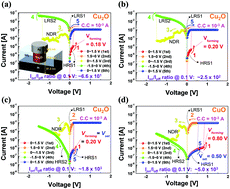An electroforming-free mechanism for Cu2O solid-electrolyte-based conductive-bridge random access memory (CBRAM)†
Abstract
In a CuxO solid-electrolyte-based CBRAM cell using an Ag top electrode, electroforming-free and electro-reset processes could be achieved at a specific ex situ annealing temperature of the solid electrolyte (i.e., 250 °C, cubic crystalline); however, below 200 °C (i.e., cubic crystalline), no electro-reset process was found and above 300 °C (i.e., monoclinic crystalline), an electroforming process was necessary. The ex situ annealing temperature of the CuxO solid electrolyte determined the remaining metal (i.e., Cu2+) vacancy concentration of the CuxO solid electrolyte, i.e., a higher annealing temperature led to a lower remaining Cu2+ vacancy concentration. As a result, a shallower diffusion depth of metal (i.e., Ag) atoms in the CuxO solid electrolyte could be obtained at a higher ex situ annealing temperature. Since the diffusion depth of Ag atoms decides the shape of the metal (i.e., Ag)-atom filament, the presence of an electroforming or electro-reset process was determined by the precise shape of the Ag-atom filament in the CuxO solid electrolyte, i.e., a shallower diffusion depth of the Ag atoms led to a more inversely conical shape of the Ag-atom filament. The detailed shapes of the Ag-atom filament were simulated by using the diffusion depth profile of metal atoms and the finite element method; in this simulation, a shallower diffusion depth of the Ag atoms led to a more inversely conical shape of the Ag-atom filament. In addition, the shape of the Ag-atom filament was well correlated with the presence of an electroforming or electro-reset process, that is, both electroforming and electro-reset processes were achieved at a moderately inversely conical shape of the metal-atom filament.



 Please wait while we load your content...
Please wait while we load your content...